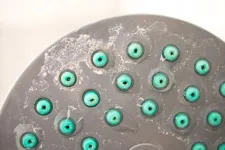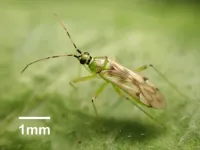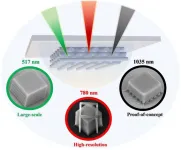(Press-News.org)
Step aside tropical rainforests and coral reefs — the latest hotspot to offer awe-inspiring biodiversity lies no further than your bathroom.
In a new Northwestern University-led study, microbiologists found that showerheads and toothbrushes are teeming with an extremely diverse collection of viruses — most of which have never been seen before.
Although this might sound ominous, the good news is these viruses don’t target people. They target bacteria.
The microorganisms collected in the study are bacteriophage, or “phage,” a type of virus that infects and replicates inside of bacteria. Although researchers know little about them, phage recently have garnered attention for their potential use in treating antibiotic-resistant bacterial infections. And the previously unknown viruses lurking in our bathrooms could become a treasure trove of materials for exploring those applications.
The study will be published Wednesday (Oct. 9) in the journal Frontiers in Microbiomes.
“The number of viruses that we found is absolutely wild,” said Northwestern’s Erica M. Hartmann, who led the study. “We found many viruses that we know very little about and many others that we have never seen before. It’s amazing how much untapped biodiversity is all around us. And you don’t even have to go far to find it; it’s right under our noses.”
An indoor microbiologist, Hartmann is an associate professor of civil and environmental engineering at Northwestern’s McCormick School of Engineering and a member of the Center for Synthetic Biology.
The return of ‘Operation Pottymouth’
The new study is an offshoot of previous research, in which Hartmann and her colleagues at University of Colorado at Boulder characterized bacteria living on toothbrushes and showerheads. For the previous studies, the researchers asked people to submit used toothbrushes and swabs with samples collected from their showerheads.
Inspired by concerns that a flushing toilet might generate a cloud of aerosol particles, Hartmann affectionately called the toothbrush study, “Operation Pottymouth.”
“This project started as a curiosity,” Hartmann said. “We wanted to know what microbes are living in our homes. If you think about indoor environments, surfaces like tables and walls are really difficult for microbes to live on. Microbes prefer environments with water. And where is there water? Inside our showerheads and on our toothbrushes.”
Diversity and opportunities
After characterizing bacteria, Hartmann then used DNA sequencing to examine the viruses living on those same samples. She was immediately blown away. Altogether, the samples comprised more than 600 different viruses — and no two samples were alike.
“We saw basically no overlap in virus types between showerheads and toothbrushes,” Hartmann said. “We also saw very little overlap between any two samples at all. Each showerhead and each toothbrush is like its own little island. It just underscores the incredible diversity of viruses out there.”
While they found few patterns among all the samples, Hartmann and her team did notice more mycobacteriophage than other types of phage. Mycobacteriophage infect mycobacteria, a pathogenic species that causes diseases like leprosy, tuberculosis and chronic lung infections. Hartmann imagines that, someday, researchers could harness mycobacteriophage to treat these infections and others.
“We could envision taking these mycobacteriophage and using them as a way to clean pathogens out of your plumbing system,” she said. “We want to look at all the functions these viruses might have and figure out how we can use them.”
Most microbes ‘will not make us sick’
But, in the meantime, Hartmann cautions people not to fret about the invisible wildlife living within our bathrooms. Instead of grabbing for bleach, people can soak their showerheads in vinegar to remove calcium buildup or simply wash them with plain soap and water. And people should regularly replace toothbrush heads, Hartmann says. Hartmann also is not a fan of antimicrobial toothbrushes, which she said can lead to antibiotic-resistant bugs.
“Microbes are everywhere, and the vast majority of them will not make us sick,” she said. “The more you attack them with disinfectants, the more they are likely to develop resistance or become more difficult to treat. We should all just embrace them.”
The study, “Phage communities in household-related biofilms correlate with bacterial hosts but do not associate with other environmental factors,” was supported by Northwestern University.
END
Obesity and type 2 diabetes are risk factors for various malignancies, including pancreatic cancer, which has a high death rate. A new analysis in Diabetes/Metabolism Research and Reviews suggests that weight-loss surgery—also called metabolic-bariatric surgery—may lower the risk of developing pancreatic cancer in people with obesity, especially in those who also have type 2 diabetes.
In the systematic review and meta-analysis, investigators identified 12 relevant studies that explored the effects of metabolic-bariatric surgery on pancreatic cancer incidence, with a total of 3,711,243 adults ...
In research published in Advanced Science, investigators drew inspiration from the octopus to develop an adhesive that achieves strong attachment and controlled release on varied substrates in wet and underwater environments. The feat could have numerous applications in fields ranging from healthcare and underwater robotics to infrastructure repair.
By studying the octopus’s suckers—specifically, the exposed disc-like portion called the infundibulum—the researchers designed an elastic, curved stalk with a membrane that can change its shape ...
Individuals at risk of anaphylaxis—an acute systemic hypersensitivity reaction to an allergen or trigger, typically associated with skin reactions, nausea/vomiting, difficulty breathing, and shock—are often prescribed adrenaline (epinephrine) autoinjectors such as EpiPens. A recent review published in Clinical & Experimental Allergy finds that these autoinjectors, which people use to self-administer adrenaline into the muscle, can deliver high doses of adrenaline into the blood, but these levels are short-lived and may not be sufficient to save lives in cases of fatal anaphylaxis.
Investigators noted that data from animal and human studies ...
New research in Medical and Veterinary Entomology reveals that when rhinoceros are found dead after being illegally killed by poachers, analyzing insects on the decomposing body aids in estimating the time since death. This information has been used by investigators and officials to construct cases against suspected perpetrators.
The study included 19 rhinoceros that were illegally killed and dehorned in the Republic of South Africa between 2014 and 2021. Scientists collected 74 samples of insect evidence from these rhinoceros remains, ...
New research published in Acta Paediatrica suggests that children who engage in outdoor play during their preschool years have a lower risk of developing obesity later in childhood.
The study included children born in Japan during two weeks in January and July 2001. Of 53,575 children born, 42,812 had data on outdoor play habits at age 2.5 years. In a survey, parents were asked, “Where do your children usually play (excluding home residences and daycare centers attended)?” Available options for answers included “in my garden or on the grounds of my apartment complex,” “in parks,” “in natural areas such as ...
A new paper in Rheumatology, published by Oxford University Press, finds that consuming more caffeine may improve heart health.
Vascular disease, damage of blood vessels, and their resulting consequences, heart attack and stroke, are among the leading causes of death in the general population. In patients with inflammatory rheumatic diseases, such as lupus and rheumatoid arthritis, these risks are even much higher. This is both due to the diseases themselves and some of the treatments for them, particularly cortisone derivatives.
Until ...
Many insects are naturally infected with symbiotic bacteria, which are typically transmitted vertically from mother to offspring but are not transmitted horizontally. Understanding the effects of these symbionts is important in terms of insect pest management as they can significantly affect the biology and reproduction of insects. The predatory mirid bug, Nesidiocoris tenuis, which preys on agricultural pests such as whiteflies and thrips, is an important biological control agent. Although the symbiotic bacterium Rickettsia is often found in N. tenuis, its effects on the host have not been clarified.
A research team led by NARO and the University of Miyazaki has revealed that Rickettsia ...
Laser direct writing (LDW) employing multi-photon 3D polymerisation is a scientific and industrial lithography tool used in various fields such as micro-optics, medicine, metamaterials, programmable materials, etc., due to the fusion of high-throughput and fine features down to hundreds of nm. Some limitations of technology applicability emerge from photo-resin properties as any material modifications can strongly affect its printability due to applied photoexcitation conditions.
In a paper published at Light: Advanced Manufacturing, a team of scientists, led by Professor Mangirdas Malinauskas from Laser Research Center at Vilnius University, Vilnius, Lithuania, coworkers ...
Duke-NUS alumnus Dr Marjorie Hoang (Class of 2023) and her mentor, Professor Pierce Chow, have brought clarity to the complex decision-making process patients diagnosed with intermediate-stage liver cancer and their doctors face by creating an algorithm that can accurately calculate the likely overall survival and recurrence-free survival following surgery.
Dr Hoang, whose interest in the liver stems from her first year at Duke-NUS, undertook a transformative third-year research project under the guidance of Prof Chow, a senior consultant specialising in liver cancer surgery at the National Cancer Centre ...
Engineers have worked out how to give robots complex instructions without electricity for the first time which could free up more space in the robotic ‘brain’ for them to ‘think’.
Mimicking how some parts of the human body work, researchers from King’s College London have transmitted a series of commands to devices with a new kind of compact circuit, using variations in pressure from a fluid inside it.
They say this world first opens up the possibility of a new generation of robots, whose bodies could operate independently ...



